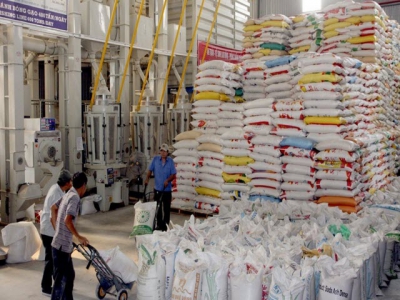Vietnam grapples with question of rice exports amid concern about food security

Vietnam, the world’s third largest rice exporter, is seeking to balance the need for sufficient rice inventories to ensure local needs and avoid shortages, and its desire to keep up exports for the income they bring in and to avoid a glut. Deputy Minister of Industry and Trade Tran Quoc Khanh addressed the issue in a recent conversation with reporters.
After the General Department of Vietnam Customs requested a temporary halt of rice exports, the Ministry of Industry and Trade immediately submitted a reverse proposal. How do you explain this?
In the beginning months of the year, the spread of the Covid-19 pandemic had serious repercussions for Vietnam and other countries around the world. The demand for a number of essential commodities, including rice, was growing very fast and there was a need to increase reserves in order to ensure food supplies.
The price of rice across the global market has fluctuated sharply. In the first two months of the year, Vietnam’s rice exports reached 930,000 tonnes, an increase of 32 percent compared to a year ago. Some markets even recorded strong rice export growth. Domestic rice prices also increased by 20-25 percent compared to a year ago, depending on rice varieties.
There was concern that if the country continued to export rice as it did in the first two months of the year, Vietnam could risk shortages for domestic consumption. Therefore, the Ministry of Industry and Trade submitted to the prime minister a number of proposals, including temporarily delaying the rice export schedule or considering specific rice export quotas. After reviewing and listening to the opinions of ministries and agencies, the prime minister decided to suspend rice exports until the end of May. The General Department of Vietnam Customs, therefore, stopped issuing clearance for rice shipments to ensure food supplies.
Subsequently, the Ministry of Industry and Trade received feedback from businesses and localities about their rice stocks, especially for output of the winter-spring crop in the Mekong Delta and inventories at businesses and in localities.
In the past, the amount of rice produced and inventories were monitored carefully. However, after Decree 107/2018/ND-CP came into effect (in 2018), we no longer had such data because businesses do not have to register trade contracts or notify local authorities about their inventories.
The Ministry of Industry and Trade immediately reported back to the prime minister in order to reconsider current inventories at businesses and in localities, as well as signed export contracts to decide whether rice exports should be stopped.
What is the Ministry of Industry and Trade’s plan for the worst-case scenario such as a prolonged pandemic or a natural disaster?
Firstly, if the pandemic continues to spread, we have a national reserve in order to guarantee a decent supply. Secondly, Decree 107 requires businesses to reserve five percent of their export volume as an emergency supply. If businesses take this requirement seriously, we have an extra reserve.
Thirdly, the Ministry of Industry and Trade has prepared several scenarios on goods circulation and distribution to prevent local shortages.
Fourthly, Vietnam’s rice crop can be planted within a short time. In the case of a prolonged pandemic in the country, it is still possible to ensure national food security.
However, we do have to keep a close eye on export volume to ensure a smooth supply of rice.
Có thể bạn quan tâm
Phần mềm

Phối trộn thức ăn chăn nuôi

Pha dung dịch thủy canh

Định mức cho tôm ăn

Phối trộn phân bón NPK

Xác định tỷ lệ tôm sống

Chuyển đổi đơn vị phân bón

Xác định công suất sục khí

Chuyển đổi đơn vị tôm

Tính diện tích nhà kính

Tính thể tích ao hồ




 Rice price escalates, Vietnamese exporters eager to resume…
Rice price escalates, Vietnamese exporters eager to resume…  Tuyên Quang rabbit farmer profits from raising New…
Tuyên Quang rabbit farmer profits from raising New…